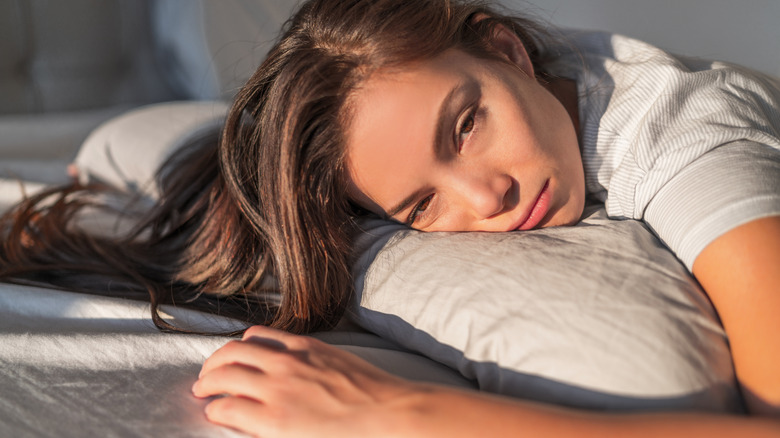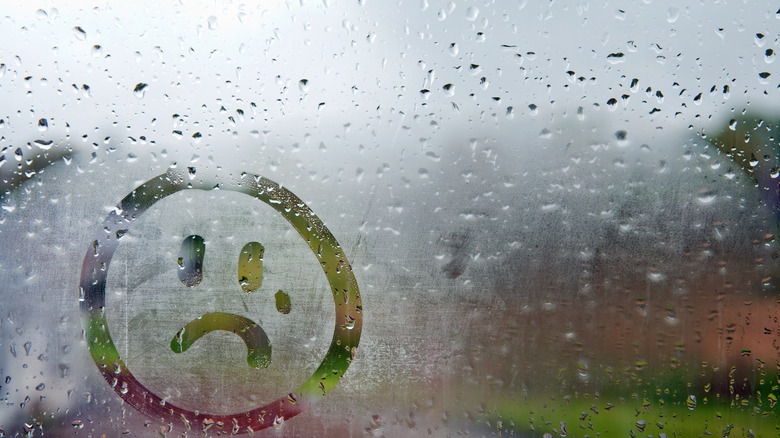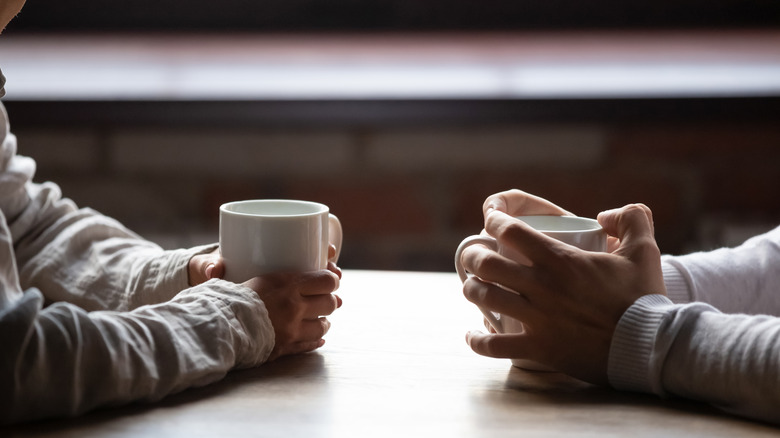What You Need To Know About Seasonal Affective Disorder, According To A Clinical Psychologist
In the summer months when the sun is hot and the days are long, everything suddenly seems supremely more alive. It's like all of the plants and the people are overflowing, opening, and vibrant. We experience a renewed sense of tender youthfulness — we don easy smiles and bare shoulders and we give ourselves permission to slow down, to enjoy the splendor of the earth and of the lives we've created. And then the weather changes, and so too does all of that.
Is everyone shedding a collective tear for the passing of summer, or did we all just get hit with seasonal affective disorder? Dr. Judith Zackson, Founder and Clinical Director of Zackson Psychology Group, explains: "Seasonal affective disorder is a type of depression associated with seasonal changes." Aptly acronymed SAD, Zackson notes that "SAD is common in the winter, but a subset [of people] also get symptoms in the summer." While most people experience fall-onset SAD, in which symptoms appear between late fall and early winter and subside when the weather turns warmer, for people with spring-onset SAD, the opposite occurs, and symptoms begin in late spring and ease with the coming of fall.
In an exclusive interview with Health Digest, Dr. Zackson explains why seasonal affective disorder happens, how it differs from other mental illnesses, and offers expert tips on how to manage the symptoms.
Why does SAD happen and what does it look like?
Of course, there's much more to seasonal depression than being bummed that our summer fun is over. So what's the deal? Dr. Zackson clarifies that SAD is triggered by changes in the amount of sunlight we're exposed to. "Exposure to sunlight impacts the production of a critical hormone, melatonin," Dr. Zackson says. "Melatonin controls our sleep cycles and how dopamine moves through the brain. Dopamine is an important hormone that affects mood and motivation." Dr. Zackson explains that melatonin levels affect dopamine signaling in the brain, leading to changes in a person's mood and behavior. When it comes to spring-onset SAD, she notes, "In the same way that insufficient light can adversely affect mood, an excessive amount of sunlight also impacts melatonin production."
Similar to the symptoms of clinical depression or relocation depression, Dr. Zackson says that the symptoms of SAD can include "feeling sad, irritable, and having decreased energy; brain fog; lack of interest in activities that used to be enjoyable; a change in appetite; increased sleep; hopelessness; and thoughts of suicide." And while this may sound similar to other forms of depression, Dr. Zackson points out that the timing of the symptoms showing up is the key. "While depression can occur anytime, SAD occurs with seasonal changes during the fall or spring," she says.
Who is affected by SAD?
The Cleveland Clinic explains that 10-20% of Americans experience a milder version of the "winter blues," but only 5% of the country experiences full-blown seasonal depression. According to Dr. Zackson, there are a few risk factors that make some people more susceptible to seasonal affective disorder than others. "Women and younger people are more prone to SAD," she reveals, adding that it's "more common in people living in places with too much or too little sunlight." Other people commonly affected by SAD are those with other mood disorders, such as major depressive or bipolar disorder, or those with a family history of depression and seasonal depression. In addition, Dr. Zackson notes that certain seasons can trigger traumatic memories associated with that time.
Despite the consuming feelings of hopelessness SAD can give rise to, Dr. Zackson explains that the situation is not hopeless at all. With some lifestyle modifications, we can often lessen the symptoms, making them more manageable so that we can get back to feeling like our summertime selves.
How to lessen the symptoms of SAD
When it comes to getting yourself back on track, Dr. Zackson says, "Begin with the basics. Commit to a healthy routine: consistent schedule, good sleep hygiene, a balanced diet, and [an] exercise regimen." Once that's in order, she says it's time to focus on replacing negative thinking. "Learn to recognize the symptoms of SAD, such as negative thoughts. Recognize that it's depression and not reality. Retrain your brain to associate those seasons with positive memories, focusing on positive aspects you could be grateful [for]."
Dr. Zackson also emphasizes the importance of a good support system. "Surround yourself with friends and relatives," she advises. "Keep in mind that depressive thoughts fuel isolation. Instead, surround yourself with loved ones, even if you do not feel like it." And try to make it easier on yourself, she urges. "Postpone important decisions, such as getting married or divorced or changing jobs, until you feel better. Discuss decisions with others who know you well and have a more objective view of your situation."
Once the fog begins to lift a little, Dr. Zackson says a little introspection can do a world of good. "Increase your awareness. Do you associate the beginning of summer or winter with a traumatic memory? Does summer trigger negative body image? Do the winter holidays trigger financial stressors or family trauma? Plan positive rituals and activities during those vulnerable times. The mindset you have will help you fight through it."
What to do if you need more help
Sometimes we need a little more help than we are able to give ourselves, and that's okay. If you feel like you just can't pull yourself out from under the weight of seasonal affective disorder, Dr. Zackson says to seek out a "clinical psychologist, psychiatrist, [or] psychotherapist trained to assess, diagnose, and treat mental health disorders." Specialists of this kind can offer treatment options for people experiencing SAD — like cognitive behavioral therapy. "Cognitive behavioral therapy (CBT) focuses on identifying negative thinking and replacing [it] with more positive and realistic thoughts and behaviors," which, Dr. Zackson explains, could be beneficial for people suffering with seasonal affective disorder.
The National Institute of Mental Health adds that along with psychotherapy, light therapy, antidepressant medication, and vitamin D supplementation can also prove to be useful in fighting SAD. Talk to your healthcare provider about which options might be best for you.
To learn more about Dr. Judith Zackson and her practice, visit her website.





